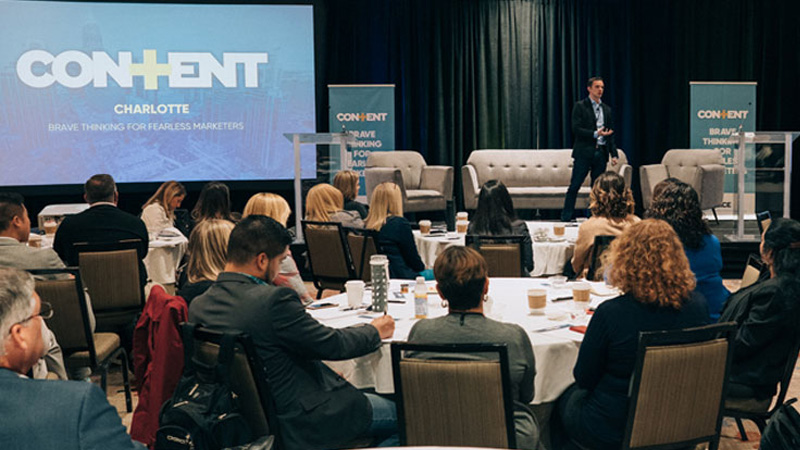Our passion at Pace is to tell stories powered by insights that bring about meaningful change. It is my north star as the executive creative director. To achieve these results, it is important for creatives to understand and use data, especially as the industry moves from traditional marketing to a data-driven model. At Pace, we believe data inspires, metrics drive and creativity connects.
At Pace, we believe data inspires, metrics drive and creativity connects.
— Neil Marion, Executive Creative Director, Pace
Data-driven creative gives us access to truth and insights—and to rapid metrics.
Data driven creative is truly the future of marketing. It uses known information about consumers and their journey to purchase along with artificial intelligence to create custom and personalized creative that engages with them with the right message at the right time.
But let’s start at the beginning. At Pace, we start with data and insights. In fact, I tell my team that a good creative leader will always dig deep for the authentic “why” in the work. You have to use data to get to the why. You can’t do that with opinions and emotions, or else your work could be talking to the wrong audience and will not connect with tone and visuals.
For example, across mindsets, many agencies and brands want Gen Z or millennial acquisition creative developed. If we do not consider the mindsets and subsets of millennials and Gen Z, we miss the fact that older people within the millennial set can be vastly different or that insights and data may point to a unique set of values across the oldest subset of Gen Z and the youngest of millennials.
A visual example would be slick, polished high-production creative that may not work with some age groups who value nostalgia and more authentic, raw real-to-life creative. At Pace, we use rigorous audience dynamics data to uncover these insights.
We look for white space and angles in how to tell a story or build a campaign and executions that will best connect to small subsets of consumers or even individuals. Pace has often been asked to use this data-driven approach to lift and shift how a brand tackles a market opportunity. Our clients such as Wells Fargo, Four Seasons, Verizon, Gold’s Gym and PepsiCo have seen a difference in how our creatives use not just data, but the right insight from a vast array of data.
Magic happens when the smartest person in the room is paired with the most creative person in the room.
Let’s be honest—competitors most likely have access to similar raw data. It’s Pace’s task to point to the right insights and to write a creative brief that contains the source of truth yet is flexible and allows creatives to explore the subsets. It’s my team’s and my responsibility to ensure the creative idea will connect with the audience along their journey to purchase.
One advantage of data-driven creative at Pace is our rapid access to metrics. Pace also does a lot of test-and-learn. Test-and-learn may sound cliché, but the Pace team has discovered the art and science of it. We have mastered it in a way that rapidly gets insights back in the hands of creatives.
If a creative is paired with a planner or strategist, they can truly work magic—but the creative needs to be open to feedback and not cave in to “opinionating,” which can have negative consequences. Another challenge is how the insight and the creative are shared with a client, whether internally or externally. There is a science to getting the best ideas and executions to market.
This is where the truly data-driven approach lives and thrives, when the smartest and most creative people work together, we take the high-level brand campaign idea and personalize and optimize tactics for the consumer and the different audiences. These insights can be driven, for example, by demographic, geographic, psychographic or behavioral data.
I know the next question is how do we know what content should be targeted to whom? We use data gleaned from the consumer journey to develop a content map. The map prevents us from boiling the ocean with content. We use it to be mindful and prioritize the most engaged audience or the most engaged points in the consumer journey.
For example, for STAINMASTER™ Carpet, the length of the sale cycle is seven years. Another creative effort might have put all the messaging into the market thinking people would flock to Lowe’s or another flooring dealer and just start buying carpet off the shelves. We discovered you have to create that relationship over time to engage those customers at the right point in the seven-year cycle. We developed content and messaging that targeted the consumer mindset at the right moment in their journey.
For data-driven creative to work, you have to hit the books.
The key to all of this is research. Pace does research, but we highly encourage any brand leader to invest in getting the right research, ensure data is clear, look at what has worked for other brands, be clear about the desired outcome, be open and challenge assumptions, consider the possibilities and be receptive to new paths forward. Taking shortcuts to insights and getting the story from the data without the cleanest takeaways may cause a poor investment in a creative effort.
For example, working with Gold’s Gym, a lot of the data being used was focused on identifying their look-alike audiences because they want more of them. As they transitioned their brand and the creative transformed, insights helped them understand a whole new set of opportunities they had not considered because they were not looking at the whole story from the data.
“Let me explain. No, there is too much. Let me sum it up.”
Data-driven marketing, when executed correctly, can tell your story, build connections and move your audience to action. Contact Nicole Martin, vice president, Strategy and Marketing Solutions, to learn more about how Pace utilizes data-driven marketing and AI to inspire results.



